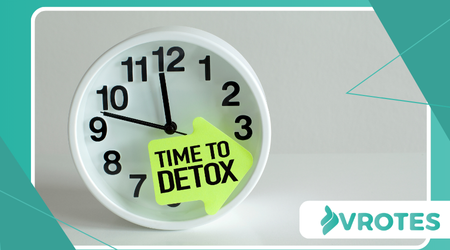Digital Detox Plan to Improve Sleep and Mental Clarity

Digital detox plan. In our hyper-connected world, the constant ping of notifications and the endless scroll of social media have become the soundtrack to our lives.
While technology offers undeniable benefits, its pervasive presence often comes at a hidden cost: disrupted sleep and a fogged-over mind.
This pervasive digital presence demands a conscious effort to reclaim our mental peace and restorative rest.
We often find ourselves caught in a cycle of digital overstimulation. From the moment we wake to the last glance before bed, screens dominate our attention.
This relentless digital consumption is subtly eroding our well-being.
The insidious nature of this digital overload often goes unnoticed. Many attribute their fatigue and lack of focus to other factors. Yet, the evidence points overwhelmingly to our device usage.
It’s time to acknowledge the elephant in the room. Our relationship with technology needs a serious re-evaluation. A strategic withdrawal is not a luxury, but a necessity.
This isn’t about abandoning technology altogether. It’s about establishing healthier boundaries. We seek to cultivate a more intentional digital life.
Think of it as hitting the reset button on your brain. A deliberate step back can work wonders. Your mind deserves a break from the constant barrage of information.
Our brains are not designed for perpetual digital input. They need periods of quietude and reflection. This allows for proper processing and integration of experiences.
Ignoring this need can lead to chronic sleep issues. It also contributes to persistent mental fogginess. The signs are often subtle at first.
Headaches, irritability, and difficulty concentrating are common indicators. These symptoms are often dismissed as everyday stress. But they might signal something deeper.
How Screens Steal Your Zs
The blue light emitted from screens is a major culprit. It suppresses melatonin production, our natural sleep hormone. This disrupts our circadian rhythm, the body’s internal clock.
Even a quick check of your phone before bed can be detrimental. It signals to your brain that it’s still daytime. This makes falling asleep incredibly difficult.
Moreover, the content we consume online often stimulates our minds. Late-night news, exciting videos, or engaging social media posts keep us alert. Our brains struggle to switch off.
This creates a vicious cycle. Poor sleep leads to reduced cognitive function the next day. This, in turn, can make us more reliant on digital distractions.
Consider a recent study by the Pew Research Center in 2018, which found that 89% of Americans say they go online daily, with 31% saying they are online “almost constantly.”
See how interesting:Tips to Reduce Stress Without Adding Time to Your Day
This pervasive engagement undoubtedly impacts our nocturnal patterns and mental states.
We are, in essence, conditioning ourselves for wakefulness. Our bedrooms, once sanctuaries of rest, become extensions of our digital workspace. This blurring of lines is problematic.

The Fog of Digital Overload: Impact on Mental Clarity
Beyond sleep, constant digital engagement clutters our minds. Our attention spans are shrinking. Multitasking, often praised, fragments our focus.
We jump from one task to another, rarely completing anything deeply. This surface-level engagement hinders critical thinking. It impairs our problem-solving abilities.
The sheer volume of information can be overwhelming. Our brains struggle to filter out noise from valuable insights. This leads to decision fatigue.
Social media, in particular, can be a major drain. The constant comparison and curated realities create anxiety. We often feel inadequate or left out.
This perpetuates a state of mild, chronic stress. Our nervous systems are constantly on high alert. This prevents true mental relaxation.
Imagine your mind as a beautiful, clear lake. Each notification, each email, each scroll adds a ripple. Soon, the surface is a chaotic mess, impossible to see through.
This is the effect of digital overload on our mental clarity.
Creative thought often emerges from periods of quiet contemplation. When our minds are constantly stimulated, this space is eroded. We lose touch with our inner thoughts.
The ability to simply “be” without external input becomes rare. This is where true introspection happens. This is where new ideas are born.
Without it, we operate on autopilot. Our responses become reactive, not reflective. We become less mindful in our daily lives.
Crafting Your Digital Detox Plan: Practical Steps
A successful digital detox plan doesn’t require a dramatic overhaul. Small, consistent changes yield significant results. The key is intentionality.
Set Clear Boundaries for Screen Time
This is perhaps the most crucial step. Define specific times when devices are off-limits. Consider a “digital curfew” an hour or two before bed.
Your bedroom should be a screen-free zone. This includes TVs, tablets, and phones. Invest in an actual alarm clock.
Read more: Guided Meditation Scripts for Hormonal Turmoil
Designate “no-phone” zones in your home. The dining table, for instance, is perfect for this. Reclaim family meal times.
Prioritize Analog Activities
Replace screen time with enriching alternatives. Read a physical book. Go for a walk in nature.
Engage in a hobby that doesn’t involve a screen. Try painting, knitting, or playing a musical instrument. Reconnect with the tangible world.
Spend quality time with loved ones, face-to-face. Engage in meaningful conversations. These interactions nourish your soul.

Cultivate Mindful Digital Habits
When you do use devices, be present. Avoid mindless scrolling. Ask yourself: “Why am I picking up my phone?”
Turn off non-essential notifications. Most apps don’t need to constantly demand your attention. Take control of your alerts.
Batch your email and social media checks. Instead of constant monitoring, dedicate specific times. This reduces distraction throughout the day.
Prepare for the Transition
It won’t be easy at first. You might experience withdrawal symptoms. This is normal and temporary.
Communicate your plans to friends and family. Let them know why you’re doing it. Ask for their support.
Find an accountability partner. Someone who can embark on this journey with you. Support makes a big difference.
++ DIY Cooling Mist Recipes to Beat Hot Flashes
Digital Detox Activity Ideas
| Time of Day | Digital Activity to Reduce | Analog Alternative | Benefits |
| Morning | Checking phone immediately | Journaling, stretching, meditation | Sets positive tone, reduces anxiety |
| Daytime | Constant email checks | Batching email times | Improves focus, reduces interruptions |
| Evening | Scrolling social media | Reading a book, creative hobby | Enhances relaxation, fosters creativity |
| Before Bed | Watching TV/Phone | Light reading, mindful breathing | Improves sleep quality, calms mind |
Sustaining the Change: Long-Term Well-being
A digital detox plan is not a one-time event. It’s a continuous process of self-awareness. It’s about finding a sustainable balance.
Regularly assess your digital habits. Are you slipping back into old patterns? Make adjustments as needed.
Celebrate your small victories. Acknowledge the positive changes you experience. This reinforces good habits.
Remember, technology is a tool. We decide how to use it. It shouldn’t dictate our lives.
The goal isn’t deprivation, but liberation. Freedom from the constant pull of the digital world. More time for what truly matters.
Is your phone truly serving you, or are you serving your phone? This simple question can be a powerful guide.
Embracing a digital detox plan is an investment in yourself. It’s a proactive step towards better sleep and enhanced mental clarity.
It’s about reclaiming your time, your focus, and your inner peace. The path to a more balanced and fulfilling life often begins with disconnecting to reconnect.
Frequently asked questions
What is a digital detox?
A digital detox is a period when an individual intentionally reduces their use of digital devices and online platforms.
The goal is to reduce stress, improve mental well-being, and increase engagement with the physical world.
How long should a digital detox last?
There’s no set duration; it can range from a few hours a day to a full weekend, or even longer. The key is consistency and finding what works best for your lifestyle and goals.
What are the main benefits of reducing screen time?
The primary benefits include improved sleep quality, reduced anxiety and stress, enhanced focus and concentration, more time for hobbies and relationships, and a greater sense of presence and mindfulness.
Will a digital detox cure my anxiety or sleep issues?
While a digital detox can significantly improve anxiety symptoms and sleep quality, it’s not a standalone cure for clinical conditions.
It’s a powerful complementary tool that should be integrated into a broader wellness strategy.
Can I still use technology for work during a digital detox?
Yes, a digital detox is about intentional usage, not complete abstinence. You can set boundaries for work-related screen time and focus on reducing recreational or non-essential digital activities.
